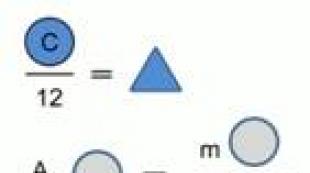Triangle pattern. Types, analysis and trading strategy
Technical analysis figure " descending triangle" portends a fall in price, regardless of the previous trend.
Descending triangle cannot be classified as either trend continuation patterns or reversal patterns, because Regardless of the direction of the trend in front of the figure, the price falls. But it is worth remembering that in In most cases, a descending triangle forms after a downtrend. Therefore, it can also be classified as a trend continuation pattern.
Descending triangle(English: descending triangle) - not very common, but quite simple figure of technical analysis. To form a figure, you need a clear support line, with at least 2 touches, and a descending resistance line, which forms the upper side of the triangle. Because the top line is at a negative angle, and the bottom line is horizontal, the resulting angle points to the right and down.
Read also Double bottom (reversal pattern) Double bottom is one of the most common reversal patterns found after a downtrend. The Double Bottom figure is very...
If you connect two lines with a vertical line on the left, as is done in the CRM chart, you get a right triangle. The top side becomes the hypotenuse, and the support and right vertical line become the legs.
Important elements of the descending triangle pattern
- Price waves should form clear line of support. Naturally, it may not be perfectly horizontal and the levels of the minimums may differ slightly, but it should be a horizontal support line with .
- On the other side of the waves, the price should emerge descending resistance line, i.e. hypotenuse. The price must touch it at least 2 times.
- General descending triangle duration, as a rule, is 3-30 weeks. On average, 1-3 months is the most common duration of a descending triangle.
- Trading volume during the formation of the figure, it usually decreases. But at the very end of the pattern, the volume increases significantly (see chart above).
- When is the price crosses the support line, the figure comes to an end. Often this final crossover is accompanied by high trading volume.
- Support turns to resistance, and after crossing support, the price may bounce off new resistance before the downtrend.
- target price equal to the height of the descending triangle subtracted from the support line.
If you look at the figure " descending triangle"From a psychological point of view, you can understand the price behavior. Many imaginary buy orders settled at the support level;
A positive result from trading with graphic patterns is possible only if their structure is simple enough to be identified on a chart even by novice traders. Regardless of the asset used, timeframe and current market trend (trend, pullback, flat). One of these universal tools is the figure « Triangle Forex » .
Basic structure and types of triangles
Triangle Forex, unlike most graphic patterns, most often appears in its classic form. At short intervals there are deviations from the norm, but with experience and knowledge of the characteristics of a particular asset, you can successfully trade such non-standard patterns.
Ascending Triangle
The lower resistance level is built along three successively increasing lows, which indicates the imminent end of the upward trend and profit-taking by the majority of players. The Forex triangle is giving way to sideways consolidation, and the trend can only resume if there are a large number of pending buy (BUY) orders above the upper border. The closer breakdown, the less range (amplitude) of price fluctuations.

The strongest signal will be a breakdown of the upper resistance down up . If an ascending triangle begins its formation “from above” and only then a breakout follows, it is better to miss the signal or open with a minimum volume with a small Take Profit.
Descending triangle
The upper boundary consists of several successively decreasing maximums, the lower one works like the current one level of support. If we analyze this situation from the point of view of market psychology, we can say that such a triangle in trading means the desire of large players to reverse the downward trend using pending orders. The same rule applies - the amplitude of price fluctuations decreases as it approaches the breakout point. Thus, the downward trend is likely to continue.

The conditions opposite to the ascending pattern must be met: first of all, we look for the price to go back from top to bottom, followed by breaking through the lower border. If the price enters the Forex triangle after several border retests, it is better to stay outside the market.
Always remember that downward trends, according to statistics, are shorter than upward ones, since the potential of sellers is always less than that of buyers. The paradox is that it takes a lot of effort to bring the market down, and on the chart it looks like periodic false breakouts. Also, the triangle in trading is highly dependent on fundamental events that can “break” the figure at any moment.
A descending triangle is a reliable signal that prices will begin to fall in the near future. Support levels always attract buyers - each unsuccessful retest leads to an increase in the volume of open and pending positions for sale among small and medium-sized players, and new local highs are formed. But large participants have already opened sales and in fact the market is already bearish in the medium term, so look at lower timeframes, where the first signs of the beginning of the fall appear.
An isosceles figure in which, after breaking through the border crossing point, the market can go both up and down with equal probability.

Most often appears before the end of a sideways consolidation, followed by a strong trend. The most important point is to correctly identify the pattern, which at the very beginning is very similar to an ascending triangle or “Flag”.
Expanding Triangle
The situation is the opposite of symmetrical: the angles of the lateral borders are approximately the same, the intersection point is on the left. This triangle in Forex trading takes longer to form than others with several local price extremes near the borders. In this case, oscillators are usually in their extreme zones. The price moves mainly due to swing intraday transactions with a gradual increase in volumes, which leads to the expansion of the figure.

The difficulty of determining current price extremes leads to mistakes, especially for beginners. Therefore, we need to make sure that we are dealing with a true breakdown of the boundaries. You need to remain calm and do not open “internal” transactions, which will not give big profits - wait until the Forex triangle finally confirms the trend reversal.
We do not open positions during minor price fluctuations - in this case, the current triangle in trading most likely will not be completely completed. When the fluctuations are at the level of average daily volatility, you can look for an entry point after rebounds from the boundaries, especially if the falsehood of the breakout is confirmed by additional tools.
An expanding or ascending triangle will be a strong reversal signal if it is formed at the end of a trend. You can open sales after the price rolls back into the pattern at the breakdown of the lower border.
"Wedge"
This triangle in trading is more dependent on the speculative component of the market than the previous options, and with equal probability can indicate both a reversal and a continuation of the trend. On the chart, the Wedge can easily be confused with a trend channel because both boundaries are directed in the same direction and do not have a clear tendency to converge. A continuation pattern appears on pullbacks and corrections, while a reversal pattern goes in the direction of the current trend.

For the “Wedge” to fully form, a strong, preferably medium- and long-term trend is required. In this case, correct processing occurs in most cases and on any assets. On timeframes smaller than H1, the number of false signals increases sharply, or the result is another figure, for example, a classic descending triangle.
Classification and correct practice
The triangle in trading on Forex and other financial assets refers to graphic figures of double interpretation:


- as in all other technical analysis patterns, the reliability of the signal increases from lower to higher time frames. We also monitor the dynamics of changes in volumes - even tick ones. The longer the price moves inside the triangle, the more market activity drops, and a sharp increase in volumes usually occurs immediately before the pattern breaks out.
- when the figure is not yet fully formed, but the price begins to move quickly beyond the calculated boundaries, you can already open a deal, especially if it is a descending triangle, and if there is additional confirmation;
- A breakdown of the border by fundamental news will be false in most cases - during these periods the market is especially unpredictable. The Forex triangle can either form further or transform into a more complex figure, such as the “Diamond”.
- At least one additional confirmation of a breakout by an oscillator or moving average is required. As practice has shown, Fibonacci levels work well on timeframes H1 and higher - wait for the price to break through the nearest correction or expansion level and open a deal.
- An expanding Forex triangle allows trades inside as long as its width is within the average daily volatility. Going beyond its limits indicates an approaching market overbought or oversold - the market can quickly reverse, it is recommended to fix profits/losses on open positions. Long-term consolidation may also begin, especially when there are no market makers in the market. This usually happens on holidays or at the end of the week.
To summarize, we can say that any Forex triangle clearly indicates periods of equilibrium between buyers and sellers - neither party can move the price in the desired direction and a redistribution of resources occurs. The opposite situation is with the “Wedge” pattern - its appearance will be a signal of speculative actions by market makers squeezing small players out of the market and accumulating positions to resume or reverse the trend, which is clearly visible from the increase in volumes.
The ability to correctly find and work out triangle patterns should be in the arsenal of any trader, regardless of the asset used (currencies, stocks, futures, options) - the rules are the same for everyone. This will make your trading more stable and with less risk.
The name of this figure is probably known to every trader. The “Triangle” is one of the basic figures of the classical market. Let's once again take a closer look at this pattern in terms of the reasons for its occurrence, analysis of its strength (true or false), and also talk about a trading strategy based on the “Triangle” pattern.
First, let's look at the internal classification of triangles. Yes, yes, this figure is not as simple as it seems, and has three subtypes:
- Ascending Triangle
- Descending triangle
Let's look at them in order, starting with the symmetrical triangle shown in the figure below. The “Triangle” figure of this particular type is found on price charts more often than others.
Example of a symmetrical triangle
As you can see, a symmetrical triangle is formed by the price sandwiched between two converging trend lines. One of these lines slopes downward, the other slopes upward. Where the price will go when exiting the pattern is not known in advance, however, as a rule, on large scales the exit from the symmetrical triangle occurs in the direction of the trend preceding the beginning of the formation of this pattern.
Traders who trade this pattern generally prefer to place patterns on either side of the tapering top.
Analysis of the symmetrical “Triangle” pattern
As with other technical analysis patterns, I use a simple volume indicator (Volume indicator) to assess the strength and truth of a given pattern. The indicator readings are interpreted as follows:
 Symmetrical Triangle Analysis
Symmetrical Triangle Analysis Volumes tend to increase when the price begins to move in the direction of the main one and fall on its pullbacks and corrections. Therefore, if an increase in volumes accompanies an upward price movement, then the triangle is likely to break through upward and further increase the price. Similarly, if the downward price movement is accompanied by an increase in volumes, then the downward pattern is likely to break through and the price will further fall.
As you can see, in the figure, the increase in volumes initially accompanied the downward price movement. Then, as the pattern formed, volumes began to grow in the direction of price growth, which ultimately determined the price’s exit from the triangle upward.
Trading strategy using the symmetrical “Triangle” pattern
A position is opened using pending orders placed on both sides of a possible exit from the triangle (one to buy, the other to sell). As a result, when one of the orders is triggered, the second one must be deleted.
 Trading strategy on the symmetrical “Triangle”
Trading strategy on the symmetrical “Triangle” The target level is defined as the distance from the price entry into the triangle to its apex (see figure). is set at a distance equal to the target level, set aside from the exit point from the triangle.
One of the most common and most slippery models in graphical analysis is triangle. In their pure form they are rare, but the principle on which the pattern is built is found quite often and in different variations.
Tapering triangle
The most interesting, informative and often profitable pattern. At the same time, he is particularly cunning. But first things first.
Everyone understands that this a triangle is formed by gradually decreasing the distances between successive highs and lows. Simply put, by drawing straight lines along declining highs and rising lows, we will get the intersection of these two lines further in the near future. But this is a generalization. In practice, there are three formations of a tapering triangle:
- the rise of the bottom and the decline of the top occur at approximately the same slope;
- the rise of the lows has a weak angle or almost does not occur with a pronounced lowering of the highs;
- the decrease in the highs has a weak angle or almost does not occur with a pronounced increase in the lows.
Some analysts distinguish varieties of a tapering triangle into separate models, giving them uninformative “clicks” such as a pennant, but I am sure that, firstly, there is no use in uninformative names, and secondly, in any deviation this model remains a triangle, because the principle of formation does not change. Therefore, we will consider variations of a tapering triangle within a triangle.
Let's tighten it tight... how long will it hold?
A contracting triangle is a pattern of increasing tension. What happens when it is formed on the market? Let's look at the example of a typical model, when there is a clear decrease in the maximums and an increase in the minimums. The first screen shows how the price of the gbpusd pair is compressed. After a noticeable and very rapid decline, the pair found support at 1.5800, followed by corrective growth. But what next? From this moment on, a tapering triangle pattern begins to form. The bears, still harboring plans to increase profits from such successful and promising sales, resume sales, but from a lower price level. If the previous corrective high was almost at 1.5910, now the sales level has shifted to 1.5890. Bears, confident that the market will catch the opportunity to join the selling, will open shorts as early as possible so that the train does not leave with the others. And indeed, sales find a response, the price begins to go down. However, the bulls, defending their levels, also open purchases higher than last time. Now the pressure in the cauldron is growing, the bulls and bears are becoming more aggressive, the bulls are buying higher and the bears are selling lower. The price finds itself under increasing counter pressure, like a spring. Where will she shoot?
Crouched and flew
The compressed price shows the growing opposition of two groups of traders; there is no longer any smell of a fair price here. A storm is about to break out. But it’s important for us to understand where to open up. In a standard model, everything is relatively simple: whichever side of the triangle the price breaks through, we open there. The difficulty lies in the fact that the breakout must be confident. It should be understood that the lines of an imaginary triangle are an approximate guide. Often the candle closes a little above or below the border, but after that the price quickly moves inside the figure; you should learn to wait. I’m generally silent about “breakthroughs” with shadows. The second difficulty is that the breakdown of the triangle quite often resembles a dead splash instead of a victorious rocket flight. The first screenshot shows a typical case. The triangle is broken upward, there is no doubt. And it would be correct to open longs, but a sane trader should be aware that the triangle only tells us about the struggle that is happening in real time in the market. The triangle is not a magical design into which the golden calf will be imprisoned. Many traders (who are actually involved in pricing) will not even notice your triangle. But the struggle he shows is obvious to them. In this case, the bears have lost their momentum, but this does not mean that they are no longer on the market. As soon as the bulls stopped aggressively pushing the price higher, sellers resumed dumping the pair. But note for yourself the level to which they were able to do this. That's right, to the bottom point of the triangle's base. The demand is still relevant. As soon as the bears and squares (traders temporarily not actively trading) saw this, all shorts were covered and the price began to rise steadily. The possibility of such price fluctuations after the breakdown of the triangle must be taken into account by adjusting your risk calculation system to them.
Our proud Varyag does not surrender to the enemy!..
Now let's look at two other variations of the tapering triangle. Their main feature is the obvious skew of the slopes of the boundaries of the triangle. One of the faces is horizontal or almost so. Let's first consider an example with a strong rise in the lows and a weak decline in the highs. The second screenshot with poundoyen is just such an example. If we reason purely logically, then the bulls should prevail, because it is their attacks that are becoming more and more aggressive, with each new entry the purchases are made higher and higher, while the bears have taken a passive defensive position. Their audacity is not even enough to match the pressure of their opponents. Although more recently they controlled the pair, actively selling the pound. But the fact shows the opposite - the bulls were swept away and the pair's growth was buried. What is the explanation for this? This is not a special case, this is the rule. Of course, like any rule in Forex, it does not work in 100 cases out of 100, but still. The horizontal border of the triangle does not indicate the passivity of the bears (in this example), but the fact that the majority of traders are not interested in buying the asset. The fight is one-sided, and the triangle has not been broken through by the attackers. Therefore, the attackers have a rather weak potential, and the growth will not become a trend, but will remain in the category of a modest correction. Once the bulls' strength is exhausted, the bears easily and elegantly continue to short the pair.

Now for the opposite example. The bulls maintain a stubborn defense, and the bears carry out attack after attack, losing patience and each time starting closer to the enemy’s bastions. The situation is shown in the third screenshot with the audusd pair. I specially selected this example to more clearly demonstrate the above logic. The bulls are holding the line, tirelessly buying the pair from 1.0310. Sellers are increasingly turning around attempts to raise prices. In the end, the level of 1.0310 is technically broken, the bears reset the price to 1.0250. And who needs it? A flat support level indicates that too many bidders do not see the price below this level. They don't advocate too much for strong growth either, but the lower price is unfair. Sellers, having exhausted their resources on meaningless sales, _themselves_ become the reason that the price will rise. Too much has been sold, and now, at fixing prices, it is easy to go up a significant distance. Breakthrough becomes an additional benefit for buyers.

Of course, the examples discussed above do not work as mandatory templates. If there was at least one pattern that, when formed, gave 100% continuation, all the money from the interbank market would go through this pattern. However, a principle is shown here that, once understood, can help you gain an understanding of what is happening in the market and optimally coordinate your actions.
Forex triangle figure is considered the most powerful tool of technical analysis, so it is often used in their trading not only by beginners, but also by experienced traders. This figure is the easiest to understand, but at the same time it processes signals well. In addition, it can be successfully used on both long-term and short-term time intervals. Any Forex broker MT4 is suitable for trading using this tool.
A triangle in Forex can be of three types:
Descending;
- ascending;
- symmetrical.
Descending triangle – waiting for a sell signal
The figure of a descending triangle has the following form: the lower border is represented as a horizontal line, and the upper border has a downward slope. Inside the triangle, the amplitude of oscillations should gradually decay. It is believed that after the descending Forex triangle figure is finally formed, the lower boundary should be broken. Therefore, traders usually place a pending sell order just below the horizontal support level.

Rice. 1 – Example of a descending triangle
Ascending triangle – waiting for a buy signal
The figure of an ascending triangle is represented as follows: the upper border looks like a horizontal line, and the lower border looks like an upward slope. Just as in the previous case, inside the triangle the amplitude of oscillations should have a damped form. After waiting for the final formation of the figure, we should expect the upper resistance line to be broken. Therefore, it is recommended to place a pending buy order in advance slightly above the horizontal level.

Rice. 2 – Example of an ascending triangle
Symmetrical triangle - neutral model
This type is much more common than an ascending or descending triangle. If it is formed and in the presence of a damped oscillation, there are relatively equal chances of breaking through in both directions. Therefore, many traders place pending orders to simultaneously buy and sell just above or below the borders of the triangle. However, it is believed that when a symmetrical triangle is formed, the price movement in the direction of the previous trend is likely to continue. There is also an expanding triangle model, but experienced traders do not recommend considering it as a signal for entering trades.

Rice. 3 – Example of a symmetrical triangle
Triangle figure in Forex – rules for breaking through
1. The expectation of a powerful price movement immediately after the breakout should occur in a segment from half to ¾ of the entire length of the horizontal line of the triangle. If the price has not broken through the level on a given segment, then a smooth exit of the price from the triangle should be expected, and its further movement is considered uncertain;
2. The classic triangle has an odd number of waves - at least five;
3. Before entering the market based on the generated signal, you must wait for the signal to be confirmed, otherwise it may be a false breakout. If the candle closes outside the boundaries of the triangle, then you can safely enter into a trade. A rollback of the candle back to the body of the triangle is considered a false breakout;
4. Professional traders believe that a sharp and prolonged price jump is possible when the previous wave reverses before it touches the opposite border of the triangle;
5. It is not recommended to enter into trades when the price is inside the triangle!
Despite the fact that the Forex triangle figure is quite simple, it is often difficult for novice traders to determine the exact entry into the market, as well as to understand which model is now in front of them - a reversal or a trend continuation model. In order not to make a mistake in the direction of price movement, you need to wait for the candle to close above or below the borders of the triangle, which will serve as a signal to enter a trade. We also recommend that you familiarize yourself with the tools of technical and fundamental analysis in the article









